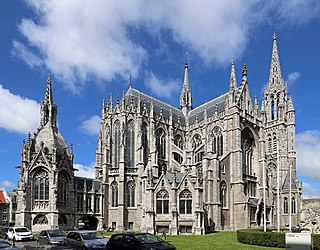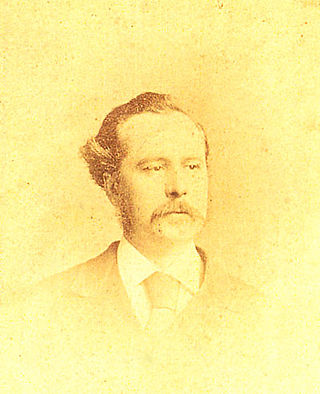
Augustus Welby Northmore Pugin was an English architect, designer, artist and critic with French and Swiss origins. He is principally remembered for his pioneering role in the Gothic Revival style of architecture. His work culminated in designing the interior of the Palace of Westminster in Westminster, London, and its renowned clock tower, the Elizabeth Tower, which houses the bell known as Big Ben. Pugin designed many churches in England, and some in Ireland and Australia. He was the son of Auguste Pugin, and the father of Edward Welby Pugin and Peter Paul Pugin, who continued his architectural firm as Pugin & Pugin.

Gothic Revival is an architectural movement that after a gradual build-up beginning in the second half of the 17th century became a widespread movement in the first half of the 19th century, mostly in England. Increasingly serious and learned admirers sought to revive medieval Gothic architecture, intending to complement or even supersede the neoclassical styles prevalent at the time. Gothic Revival draws upon features of medieval examples, including decorative patterns, finials, lancet windows, and hood moulds. By the middle of the 19th century, Gothic Revival had become the pre-eminent architectural style in the Western world, only to begin to fall out of fashion in the 1880s and early 1890s.
The year 1867 in architecture involved some significant architectural events and new buildings.
The year 1863 in architecture involved some significant architectural events and new buildings.
The year 1888 in architecture involved some significant architectural events and new buildings.
The year 1868 in architecture involved some significant events.
The year 1844 in architecture involved some significant architectural events and new buildings.
The year 1839 in architecture involved some significant architectural events and new buildings.
The year 1851 in architecture involved some significant architectural events and new buildings.
The year 1835 in architecture involved some significant architectural events and new buildings.
The year 1852 in architecture involved some significant architectural events and new buildings.
The year 1855 in architecture involved some significant architectural events and new buildings.
The year 1847 in architecture involved some significant architectural events and new buildings.
The year 1832 in architecture involved some significant architectural events and new buildings.
The year 1858 in architecture involved some significant events.

Erich Mendelsohn ; 21 March 1887 – 15 September 1953) was a German-British architect, known for his expressionist architecture in the 1920s, as well as for developing a dynamic functionalism in his projects for department stores and cinemas. Mendelsohn was a pioneer of the Art Deco and Streamline Moderne architecture, notably with his 1921 Mossehaus design.
The year 1827 in architecture involved some significant architectural events and new buildings.

Edward Welby Pugin was an English architect, the eldest son of architect Augustus Welby Northmore Pugin and Louisa Barton and part of the Pugin & Pugin family of church architects. His father was an architect and designer of Neo-Gothic architecture, and after his death in 1852 Edward took up his successful practice. At the time of his own early death in 1875, Pugin had designed and completed more than one hundred Catholic churches.
The year 1804 in architecture involved some significant events.






